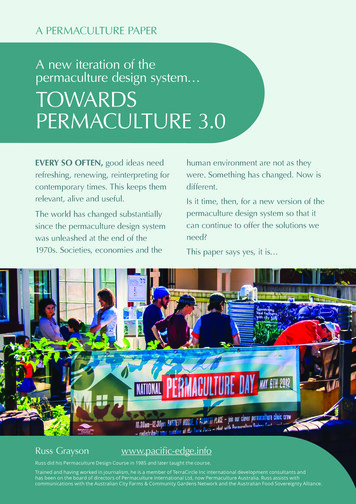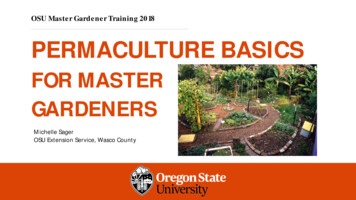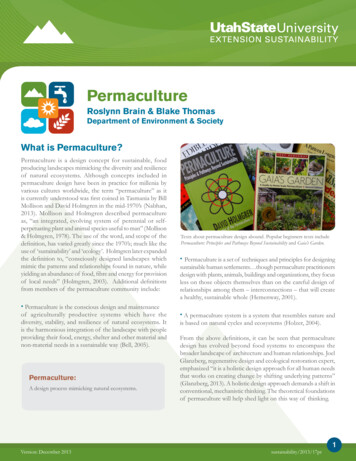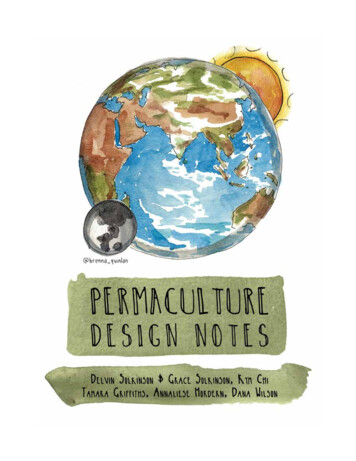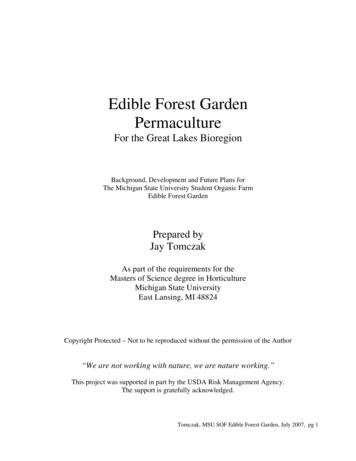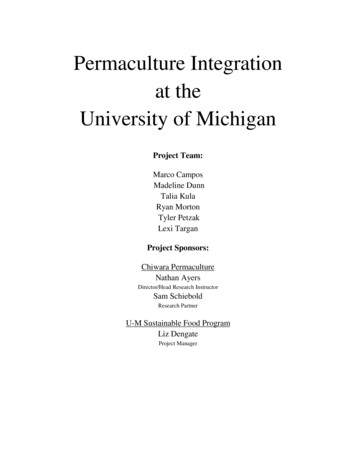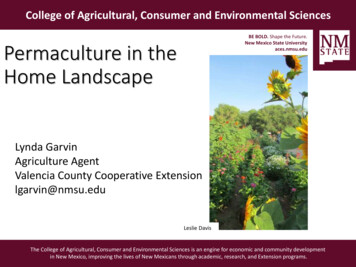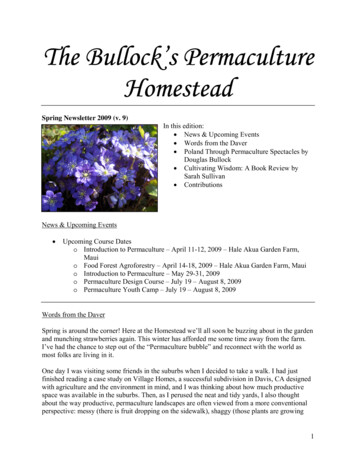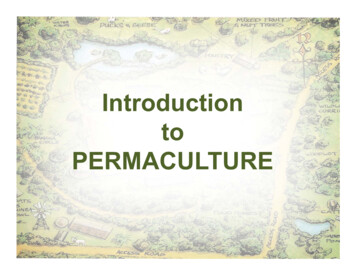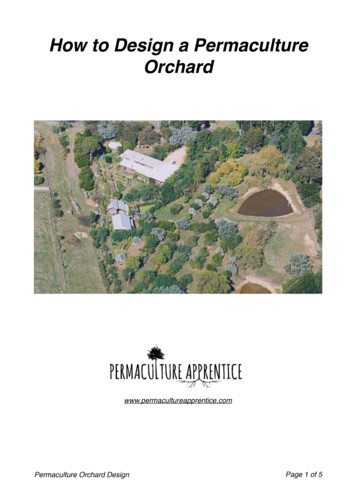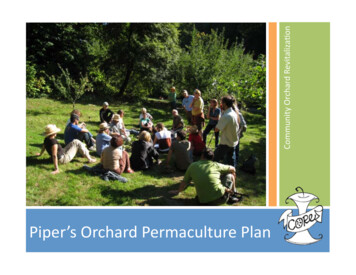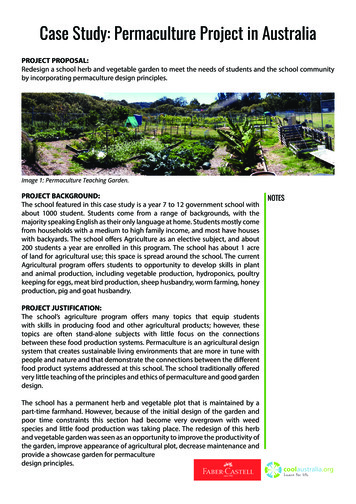
Transcription
Case Study: Permaculture Project in AustraliaPROJECT PROPOSAL:Redesign a school herb and vegetable garden to meet the needs of students and the school communityby incorporating permaculture design principles.Image 1: Permaculture Teaching Garden.PROJECT BACKGROUND:The school featured in this case study is a year 7 to 12 government school withabout 1000 student. Students come from a range of backgrounds, with themajority speaking English as their only language at home. Students mostly comefrom households with a medium to high family income, and most have houseswith backyards. The school offers Agriculture as an elective subject, and about200 students a year are enrolled in this program. The school has about 1 acreof land for agricultural use; this space is spread around the school. The currentAgricultural program offers students to opportunity to develop skills in plantand animal production, including vegetable production, hydroponics, poultrykeeping for eggs, meat bird production, sheep husbandry, worm farming, honeyproduction, pig and goat husbandry.PROJECT JUSTIFICATION:The school’s agriculture program offers many topics that equip studentswith skills in producing food and other agricultural products; however, thesetopics are often stand-alone subjects with little focus on the connectionsbetween these food production systems. Permaculture is an agricultural designsystem that creates sustainable living environments that are more in tune withpeople and nature and that demonstrate the connections between the differentfood product systems addressed at this school. The school traditionally offeredvery little teaching of the principles and ethics of permaculture and good gardendesign.The school has a permanent herb and vegetable plot that is maintained by apart-time farmhand. However, because of the initial design of the garden andpoor time constraints this section had become very overgrown with weedspecies and little food production was taking place. The redesign of this herband vegetable garden was seen as an opportunity to improve the productivity ofthe garden, improve appearance of agricultural plot, decrease maintenance andprovide a showcase garden for permaculturedesign principles.NOTES
NEEDS ASSESSMENT:NOTESAn assessment was taken of the existing herb and vegetable garden, and thefollowing needs were identified through a combination of observation, surveysand interviews with students and staff at the school: Little food production happening in showcase garden. Use of the space by students during lesson time restricted due to poor accessthrough unsafe old fencing. Unattractive appearance of garden with large weed problem, excess fencingand use of carpet as weed matting. Staff have little time to maintain current garden and redesign new garden. Limited composting and worm farming occurring despite students needingto learn such skills in year 8 vegetable production topic. Herb garden in condition and unsuitable for teaching students about plantproduction and uses in the year 9 herb topic. Existing youth-adult partnerships in the form of mentorships with localcommunity group looking for projects to complete at the school. Poor funding to buy materials and redesign the garden. Need for a showcase garden displaying good vegetable/herb productionand soil building to inspire students when they come to design their owngardens, either for yr 8 vegetable topic or in their own home. Knowledge of permaculture principles and skills lacking in school agricultureprogram.STRATEGY:In response to these needs the decision was made to redesign the showcasegarden using permaculture design principles. The garden would display goodpermaculture design in a small space equivalent to many backyards in the area.Vegetable and herb production would feature prominently in the space, and asmall food forest with perennial fruit trees would also be planted. The gardenwould also showcase good soil building techniques including worm farming andcomposting.There was little funding for redesigning and recreating the garden, and most ofthis was spent on new irrigation and fencing. In order to be successful, the newdesign needed to make use of existing recycled materials. These were sourcedon the school grounds as well as others found in local council clean ups. Othermaterials were purchased second-hand or donated by members of the schoolcommunity.The schools’ science/agriculture teacher had extensive knowledge ofpermaculture design and principles and was able to complete the conceptdesign for the new garden. The school farmhand and other teachers provided assistance with the initial deconstruction of the original garden, while the build ofthe new garden was completed with the assistance of students in years 8 and 9during lessons. Certain features of the garden, such as bath tub worm farms werecreated with the assistance of mentorship programs offered by local communitygroups. These were constructed off site and delivered to the school. The schoolfarm hand and gardener are responsible for maintaining the garden out of workhours in exchange for using half of the space for the production of food for theirown homes.
NOTESImage 2: Permaculture Teaching Gardenusing recycled materials such as oldhardwood timber, compost bins and wheelburrows (2 months into build).OutcomeImage 3: Recycled Bath Tub Worm Farm.Criteria for successImmediateStudents in the year 8 vegetable productionunit would be given the practical opportunityto learn new skills in permaculture principles,garden design and soil production.Students become motivated and inspired toconstruct their group vegetable garden usingpermaculture principles and techniques.Short TermStudents in year 9 would have access toperennial herbs in which to take cuttings andlearn about medicinal uses for the herb topic.Increase in the pace of compost production toimprove the health of plants in the area.Access to a range of healthy perennial herbs forstudents to take cuttings off and learn aboutduring lessons.Time taken to composting plant waste materialswill be decreased.Mid TermStudent knowledge in good soil management,permaculture principles and garden design willincrease. Plants will thrive in the garden dueto improved soil productivity. Increase in foodproduced in area to be used by School duringcooking lessons and by school canteen.More links to permaculture principlesincorporated into existing agricultural programwith real examples being displayed.Produce can be sold to the school canteen.Proceeds can be used to fund futureagricultural projects.Long TermCommunity knowledge in good soilmanagement, permaculture principles andbackyard vegetable production will increase asstudents take skills home with them.Teachers with knowledge of good garden designand permaculture principles will increase.Links between the school and local communitygroups established.Increased awareness of school agriculturalprogram through the running of farm stalls.Teacher development days hosted at the school.
NOTESMAIN BENEFACTORS:Students: Year 8 students gained valuable hands on experience building a garden fromscratch. Students had a permanent garden in which to gain inspiration for their ownvegetable garden designs. Less weeding of students’ own garden due to less weed species growing inold showcase plot. Students gain valuable skills in soil production and worm farming. Large bathtub work breeders can supply students own worm farms with extra wormswhen needed. Year 9 students had opportunities to gain hands on skills in working withpropagating and producing herb plants including the production ofcavendish bananas. Agricultural students have working example of good companion planting inwhich to guide them in other agricultural projects they are completing. Year 10 students have opportunity to get inspiration in the production ofpotatoes based on showcase garden. Science students in year 10 can get real world example of how plants usecloning by investigating the production of bananas in showcase garden.
Teachers:NOTES Agricultural Teachers have a permanent working example of a vegetable andherb garden in which to refer to during lessons. A selection of herbs and plants are grown in which to collect seeds andcuttings for lessons. A selection of good quality compost is available for the using during lessons. Science staff can use resources in garden for the teaching of the nitrogencycle, cloning, biological control and the lifecycle of worms. School has a working example of a permaculture garden in which to teachskills in permaculture principles to teachers. School TAS teachers have access to fresh excess vegetables to use in cookingclasses.School Farm Hand/Gardener: Access to half of the garden to produce their own food and display goodquality vegetable production in exchange for extra hours of gardenmaintenance. Easier area to manage and keep weed species under control. Increased productivity of food due to increased soil production.School Community: School canteen has access to fresh quality herbs and excess vegetables. Increased appearance of school agriculture plot when being showcasedduring open nights and Lighthouse school agriculture workshops. Increased awareness of school agricultural program during display ofproduce at local show.School Plants and Animals: Increased health of plants due to improved soil conditions. Increased productivity of fruit. Decreased incidence of weed plants and pest bugs due to companionplanting techniques. Access by chickens to mini food forest to control weeds. Supplement food inthe form of excess compost worms.Image 5: Limited plants in beds due to school holidays. Large banana plot producing hugeamounts of fruit and shading compost and worm farming area from hot afternoon sun.New fencing in place resulting in no access to by sheepor chickens.
What workedWhat did not workImmediateUse of recycled materials kept initial cost ofbuild to 200.Reduction of weeds and ease of use of spaceenabled with the removal of old fencing.Use of space used in teaching of lessons on vegetable production and permaculture principles.More time needed in initial construction due tosourcing of materials and removing nails fromold timber.Teachers put more time into the build afterschool hours due to limited time in class,restricted to 50 min lessons.Short TermStudents in year 9 involved in planting of thebananas. Quick growth of food plants due tooptimal growing conditions.Garden maintenance easier for staff.Year 8 students using garden for inspiration forown vegetable gardens.Time taken for worm farm to arrive took longerthan expected.Issue with funding for acquiring new fencingon time. Chickens and sheep gained access anddestroyed seedlings.Mid TermIncrease in food production with two types ofsoil pH in beds. Increased soil production in thespace. School canteen using excess produce.Produce displayed at local agriculture show.Limited use of the produce.Limited use of space by teachers (other thanthe science/agriculture teacher) due lack ofconfidence in teaching permaculture principles.Long TermGarden tours.Garden starts to look messy when school farmNew fencing ensures chickens keep weeds down hand is on leave.around fencing but have no access to garden.Limited use of space by teachers.Reduced weeds results in significantly reducedgarden maintenance.NOTES
Case Study: Permaculture Project in Australia PROJECT PROPOSAL: Redesign a school herb and vegetable garden to meet the needs of students and the school community by incorporating permaculture design principles. PROJECT BACKGROUND: The school featured in this case study is
